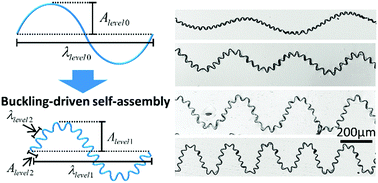Buckling-driven self-assembly of self-similar inspired micro/nanofibers for ultra-stretchable electronics†
Abstract
Self-similar structures are capable of highly enhancing the deformability of stretchable electronics. We presented a self-assembly method based on the tunable buckling of serpentine fiber-based interconnects (FiberBIs), which are deposited using our presented helix electrohydrodynamic printing (HE-printing) technique, to fabricate self-similar structures with enhanced stretchability (up to 250%). It provides a low-cost, printing-based approach for the generation of large-scale self-similar FiberBIs. Distinct buckling behaviors and modes occur under specific conditions. To elucidate the mechanics governing this phenomenon, we present detailed experimental and theoretical studies of the buckling mechanics of serpentine microfibers on compliant substrates. Firstly, the effect of the magnitude and direction of prestrain on the buckling behavior of a fiber-on-substrate is discussed. Secondly, the critical geometry of a serpentine fiber as a key parameter for fabricating uniform self-similar fibers is also figured out. Finally, the cross-sectional geometry of the fiber as a judgment criterion for determining the in-surface or out-of-surface buckling of the fiber is established. The investigation can guide the fabrication process of large-scale self-similar structures for high-performance electronic devices with extreme stretchability.



 Please wait while we load your content...
Please wait while we load your content...